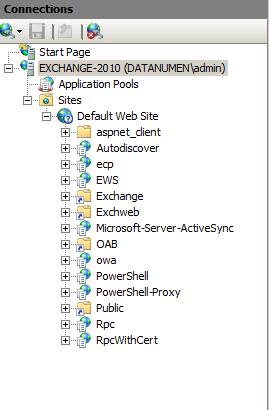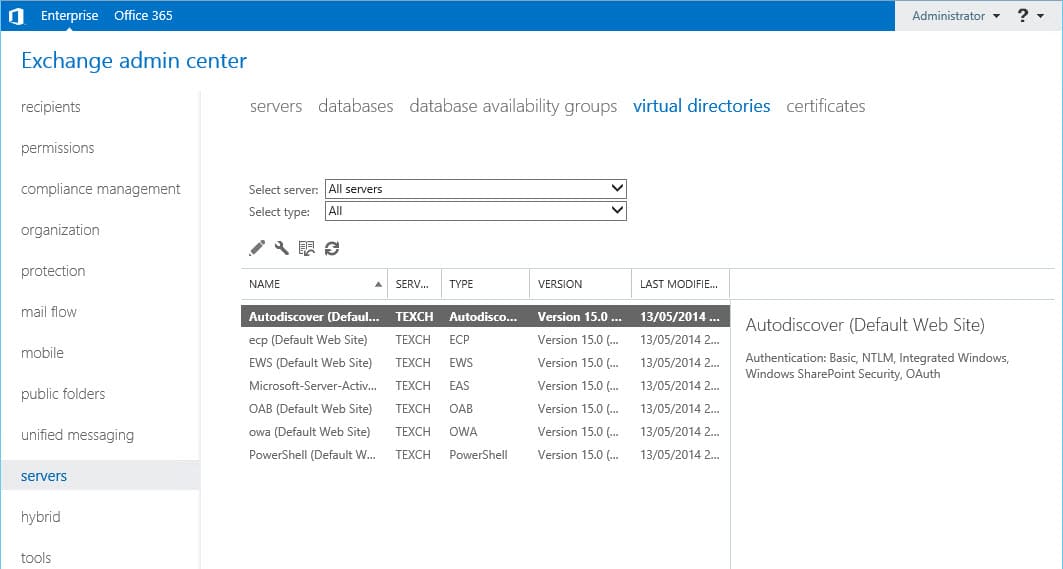In this article, we are going to see the features and functionalities of Virtual Directories of Exchange servers in detail.
Introduction:
Virtual Directories in Microsoft Exchange is used for applications and other clients that use web based services. For instance, services like ActiveSync, Outlook Web App etc., are some of the in-built features that uses Virtual Directories. They are mainly used by Internet Information services (IIS) for establishing access with the Exchange’s Web applications and mailboxes. Virtual Directories are so robust, that we can manage a variety of settings like Authentication types, Logs and Reporting etc.
Virtual Directory
They can be accessed either via the Exchange Console (2010)/Exchange Admin center (2013) or via PowerShell. Exchange Admin Centre provides very basic information about Virtual Directory options. However PowerShell gives the complete list of actions and information that can be performed on that Virtual Directory. Hence we can continue working with PowerShell which is common for all the versions of exchange.
Below are list of Important Virtual Directories.
- Autodiscover
- ECP
- EWS
- Microsoft-Server-ActiveSync
- OAB
- OWA
- PowerShell
Apart from the above there are other Virtual Directories that work with Exchange systems, they are
- Aspnet_client
- Rpc
- RpcwithCert
Each Exchange server will have its own virtual directories configured based on the roles installed on that server. The below table shows
| Directory | Authentication | Server role | Managed by |
| Autodiscover | Anonymous, Basic,Windows | CAS | Shell |
| ECP | Anonymous, Basic | CAS | EMC or Shell |
| EWS | Anonymous, Windows | CAS | Shell |
| Microsoft-Server-ActiveSync | Basic | CAS | EMC or Shell |
| OAB | Windows | CAS | EMC or Shell |
| OWA | Basic | CAS | EMC or Shell |
| PowerShell | Anonymous | CAS | Shell |
| aspnet_client | Anonymous | CAS | IIS, EMC |
| rpc | Basic, Windows | CAS | Shell |
| rpcwithcert | Disabled | CAS | Inaccessible |
| Default Website | Anonymous | Mailbox | Inaccessible |
Powershell Commands for Each Virtual Directory:
| Directory | cmdlets | Purpose |
| Autodiscover | Get-AutodiscoverVirtualDirectory | Retrieves the Current Virtual directory settings |
| New-AutodiscoverVirtualDirectory | Create a new autodiscover virtual directory | |
| Remove-AutodiscoverVirtualDirectory | Delete the current Virtual Directory | |
| Set-AutodiscoverVirtualDirectory | Modify the settings of the current Virtual directory | |
| ECP | Get-EcpVirtualDirectory | Retrieves the Current Virtual directory settings |
| New-EcpVirtualDirectory | Create a new Ecp virtual directory | |
| Remove-EcpVirtualDirectory | Delete the current Virtual Directory | |
| Set-EcpVirtualDirectory | Modify the settings of the current Virtual directory | |
| EWS | Get-WebServicesVirtualDirectory | Retrieves the Current Virtual directory settings |
| New-WebServicesVirtualDirectory | Create a new EWS virtual directory | |
| Remove-WebServicesVirtualDirectory | Delete the current Virtual Directory | |
| Set-WebServicesVirtualDirectory | Modify the settings of the current Virtual directory | |
| Microsoft-Server-ActiveSync | Get-ActiveSyncVirtualDirectory | Retrieves the Current Virtual directory settings |
| New-ActiveSyncVirtualDirectory | Create a new ActiveSync virtual directory | |
| Remove-ActiveSyncVirtualDirectory | Delete the current Virtual Directory | |
| Set-ActiveSyncVirtualDirectory | Modify the settings of the current Virtual directory | |
| OAB | Get-OabVirtualDirectory | Retrieves the Current Virtual directory settings |
| New-OabVirtualDirectory | Create a new autodiscover virtual directory | |
| Remove-OabVirtualDirectory | Delete the current Virtual Directory | |
| Set-OabVirtualDirectory | Modify the settings of the current Virtual directory | |
| OWA | Get-OwaVirtualDirectory | Retrieves the Current Virtual directory settings |
| New-OwaVirtualDirectory | Create a new OWA virtual directory | |
| Remove-OwaVirtualDirectory | Delete the current Virtual Directory | |
| Set-OwaVirtualDirectory | Modify the settings of the current Virtual directory | |
| PowerShell | Get-PowerShellVirtualDirectory | Retrieves the Current Virtual directory settings |
| New-PowerShellVirtualDirectory | Create a new Powershell virtual directory | |
| Remove-PowerShellVirtualDirectory | Delete the current Virtual Directory | |
| Set-PowerShellVirtualDirectory | Modify the settings of the current Virtual directory |
Conclusion:
The above PowerShell commands seems to be easy but we should have extra care while operating those. Otherwise we will end up with unidentifiable issues, which will not be easy to troubleshoot. Use this cmdlets in a test environment unless you are confident and completely aware of these. Sometime we might have to recreate the directories while troubleshooting. These directories are very crucial for the connectivity. If you are not able to fix it, then you can consider OST file recovery to access the emails for time being until you fix the issue.
Author Introduction:
Sophia Mao is a data recovery expert in DataNumen, Inc., which is the world leader in data recovery technologies, including repair pst file damage and word recovery software products. For more information visit www.datanumen.com
